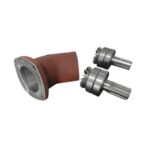As a professional aluminum die casting supplier for over 20 years, Yongzhu Casting has seen that even the smallest mold geometry detail — such as a draft angle — can determine whether a casting ejects cleanly or cracks at the mold line.
This guide explains everything buyers and engineers need to know about draft angle design, from principles and recommended ranges to how we control precision in production.
Understanding Draft Angles in Die Casting
In die casting, the draft angle is the intentional taper applied to the vertical walls of a cavity or core.
It helps the solidified aluminum part release from the die without sticking, galling, or tearing.
A properly calculated draft angle ensures:
- Smooth ejection without surface scratches.
- Reduced stress on ejector pins and mold tooling.
- Uniform dimensional accuracy even after thousands of cycles.
Typical aluminum alloys such as ADC12, A380, and AlSi9Cu3 contract slightly as they cool.
Without sufficient draft, the casting can seize on the die surface — causing tearing, marks, or die damage.
Why Draft Angle Design Matters in Aluminum Die Casting
Well-designed draft angles are crucial for:
- Ease of Ejection: Reduces friction and prevents deformation of delicate sections.
- Improved Surface Finish: Avoids scratches and drag marks on visible surfaces.
- Tooling Longevity: Minimizes wear on the die cavity and ejector systems.
- Dimensional Accuracy: Prevents stress distortion when the part cools and releases unevenly.
💡 For aesthetic die-cast parts such as furniture legs, lighting housings, or junction boxes, even a 0.5° difference in draft angle can determine whether the part meets tolerance.
Determining the Correct Draft Angle
The optimal draft angle depends on alloy, cavity geometry, wall height, and surface finish.
Below are engineering recommendations commonly applied to aluminum die casting:
| Surface Type | Typical Draft Angle (°) | Notes |
|---|---|---|
| Polished Surfaces | 0.5° – 1° | For visible or aesthetic surfaces requiring high finish. |
| Textured / Matte Surfaces | 1° – 3° | Rougher die textures need larger draft to prevent sticking. |
| Internal Cavities | 2° – 3° | To prevent vacuum lock during ejection. |
| Deep or Complex Pockets | 3° – 5° | Needed to compensate for shrinkage drag. |
| External Walls | 1° – 2° | Standard for most housing components. |
At Yongzhu Casting, these values are refined using MAGMASoft® mold flow analysis and 3D CAD compensation, ensuring optimal release angles without sacrificing precision.
Factors Influencing Draft Angle Selection
- Alloy Shrinkage Rate
Each aluminum alloy behaves differently.
High-silicon alloys (ADC12, AlSi9Cu3) flow better and can use smaller drafts, while copper- or magnesium-rich alloys need larger drafts to counter higher contraction. - Wall Height and Geometry
Tall, deep cavities require increased draft to prevent binding. - Surface Texture and Coating
Sandblasted or bead-blasted molds increase surface roughness and friction.
We typically add +1° for every 50 µm of surface roughness (Ra). - Lubrication and Die Temperature Control
Insufficient die lubrication or uneven temperature causes sticking.
Proper draft mitigates these effects while allowing balanced thermal release. - Ejection Mechanism
Multi-pin ejection systems allow smaller draft angles compared with single-pin setups due to distributed force balance.
How Yongzhu Casting Controls Draft Accuracy
At Yongzhu Casting, we integrate precision tooling, simulation, and inspection to maintain tight control over draft geometry:
- Die Casting Machines: 800T – 2000T high-pressure aluminum die casting lines.
- Tooling Room: In-house CNC + EDM with ±0.1° cavity taper tolerance.
- Simulation: MAGMASoft® and SolidWorks mold flow analysis.
- Inspection: Coordinate Measuring Machine (CMM) + vision inspection for cavity taper.
- Finishing: Robotic deburring and polishing to maintain part surface consistency.
This integrated approach ensures consistent mold release performance across lighting housings, furniture parts, and electrical enclosures produced for global OEM clients.
Common Mistakes and Their Consequences
| Mistake | Impact on Casting |
|---|---|
| Zero draft design | Parts stick to die walls; risk of tearing during ejection. |
| Excessive draft | Causes wall thickness variation and tolerance loss. |
| Ignoring alloy behavior | Leads to under- or over-compensation for shrinkage. |
| No simulation validation | Increases tool trial failures and scrap rates. |
Each of these issues can cost hours of rework or even require die re-polishing. Proper draft design is one of the simplest ways to reduce total casting cost.
Guidelines for Designing Draft Angles
- Maintain uniform draft across part geometry to prevent distortion.
- Avoid unnecessary undercuts or zero-draft regions in deep cavities.
- Balance complexity and manufacturability — prioritize consistent ejection.
- Validate draft through die-flow simulation and thermal analysis before tool steel cutting.
- Collaborate early with die makers to confirm draft compensation in CAD design.
Frequently Asked Questions
Q1. What is the ideal draft angle for aluminum die casting?
Typically 1–3° depending on alloy, part geometry, and surface finish.
Q2. Can zero draft ever be used?
Only when mirror-polished cavities and premium lubricants are applied — usually not practical for mass production.
Q3. What happens if draft angle is too small?
The part may stick, deform, or damage the die during ejection, increasing downtime and rework.
Q4. Does alloy composition affect draft requirements?
Yes. High-silicon alloys flow easily and need less draft than copper-rich alloys.
Q5. How does Yongzhu Casting verify draft accuracy?
We measure every cavity on CMM and inspect cast samples against 3D CAD to ensure taper within ±0.05 mm.
Conclusion
In aluminum die casting, precision draft angles ensure smooth ejection, flawless surfaces, and long mold life.
Through advanced simulation, process control, and strict dimensional verification, Yongzhu Casting helps global manufacturers achieve defect-free castings that balance strength, aesthetics, and cost efficiency.
Have a design drawing that needs feasibility evaluation?
Send it to yongzhucasting@gmail.com — our engineers will review the draft, gating, and tolerance setup within 48 hours.



















